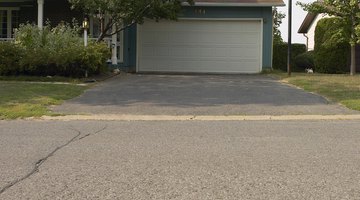What Is an Ice Melter for Aggregate Driveways?
Aggregate driveways, properly called aggregate concrete driveways, are made so natural or man-made aggregate material decorates the top of the concrete that forms the main part of the construction.

While the aggregate typically is made of stone that is impervious to deicing chemicals, the concrete beneath requires special consideration.
Deicing Aggregate Concrete That Is Not Fully Cured
Chemical deicers and salt are particularly harmful for use in the first winter after an aggregate concrete driveway has been laid, according to Exposed Aggregate Concrete. It notes that “surface scaling, discoloration or deterioration” may result. Some deicers react with chemicals in concrete. Magnesium-based deicers chemically attack aggregate concrete, replacing the calcium with magnesium. This causes discoloration, surface interruption and -- in extreme cases -- breaks down the integral bonds and promotes disintegration. Sodium chloride -- rock salt -- is “hydroscopic”; it attracts moisture and maintains it in its vicinity. The presence of liquid water increases the likely number of freeze/thaw cycles to which the concrete may be subjected. This, too, can cause discoloration and even surface damage to uncured driveways. Increasing the amount of water in and on the concrete also increases the risk that freezing cracks the material. Once the driveway has cured, use a proprietary surface sealer to finish off the installation. After the surface sealer has dried, it is safe to use rock salt as a deicer.
Ammonium Nitrate, Ammonium Sulfate, Calcium Chloride and Urea
The most common chemicals packaged as deicers are ammonium nitrate, ammonium sulfate, calcium chloride and urea. They disintegrate concrete, and should be avoided for use on driveways of any age. A number of commonly available lawn and garden fertilizers contain these chemicals, although in less intense concentrations; for this reason, it is wise to avoid cross-contamination between areas of landscaping.
Rock Salt on Fully Cured Aggregate Concrete
Once a driveway is fully cured and has weathered its first winter, it is safe to use rock salt as a deicer. Using a mixture of rock salt and traction sand reduces the amount of salt introduced into the environment without diminishing the deicing effect; such a mix usually increases traction for pedestrians and vehicles alike. As with all such products, use only the minimum necessary to achieve the desired effect; salt’s hydroscopic effects can draw moisture away from the roots of grass and trees, causing damage that lasts beyond the cold season.
Safest Ice Melters
Sand is readily available year-round in easy-to-handle bags from home improvement warehouses. It works well to deice driveway surfaces and contains no chemicals that can damage or corrupt the surface. Cat litter also works as a chemically-inert deicer in a pinch, but it is more costly than sand and less easy to rinse away after the winter season.
The Drip Cap
- Aggregate driveways, properly called aggregate concrete driveways, are made so natural or man-made aggregate material decorates the top of the concrete that forms the main part of the construction.
- Some deicers react with chemicals in concrete.
- The presence of liquid water increases the likely number of freeze/thaw cycles to which the concrete may be subjected.
- Once a driveway is fully cured and has weathered its first winter, it is safe to use rock salt as a deicer.
- As with all such products, use only the minimum necessary to achieve the desired effect; salt’s hydroscopic effects can draw moisture away from the roots of grass and trees, causing damage that lasts beyond the cold season.
References
Writer Bio
John Cagney Nash began composing press releases and event reviews for British nightclubs in 1982. His material was first published in the "Eastern Daily Press." Nash's work focuses on American life, travel and the music industry. In 1998 he earned an OxBridge doctorate in philosophy and immediately emigrated to America.
Photo Credits
- Hemera Technologies/AbleStock.com/Getty Images
- Hemera Technologies/AbleStock.com/Getty Images
More Articles



